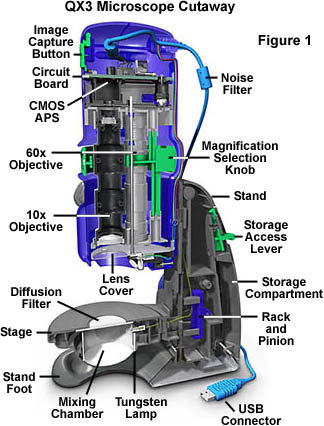Anatomy of the QX3 Microscope
The Intel QX3 Computer Microscope contains no eyepieces, and images must be viewed through the accompanying software on the host computer that controls the microscope. Construction materials used in the assembly of the microscope are typical of those found in many modern toys.

The major difference between the QX3 microscope and its predecessors is the ability to capture digital images and movies with the Intel Play microscope. Before the introduction of this remarkable microscope, students were forced to peer into eyepieces with very narrow viewfields to visualize poorly illuminated specimens through optical systems capable of producing only blurred images. Photomicrography was out of the question for all but the most expensive microscopes. Specific details of the design, construction, and operation of the QX3 computer microscope can be found in the links below.
Objective Design and Architecture - Objective design and construction is a key feature of any optical microscope. This discussion explains how the Intel QX3 objectives operate and details their features and limitations.
Objective Properties - Ray trace patterns, spot diagrams, and modulation transfer functions for the three QX3 microscope objectives are measured and discussed. Specification for plastic optics and the use of various materials in lens manufacture are also presented.
Microscope Body - Housed in the microscope body are the control and digital imaging electronics, the objectives, and an oblique illumination light source. This section discusses how the body is assembled and how the various components interact to magnify specimens and produce digital images.
Light Pathways - Illumination is perhaps the most important consideration in optical microscopy. In this section we discuss how light travels through the QX3 microscope in both transmitted and reflected light illumination modes.
Digital Imaging System - The QX3 uses an innovative new CMOS digital sensor technology to produce images that can be captured as stand-alone, time-lapse, or digital movies.
Stage and Stand - The stand assembly is an integral part of the Intel QX3 microscope when used in transmitted light mode. Although the microscope lacks a substage condenser, it does have a light mixing chamber and diffusion screen to assist in specimen illumination.
QX3 Software Interface - The software package that accompanies the QX3 microscope is both impressive and very functional. Designed with a kid-friendly interface, this interactive system controls the microscope and excels in image capture and manipulation.
Specialized Techniques - We have devised a number of modifications and specialized techniques designed to improve the performance of the Intel QX3 microscope. These techniques are very easy to follow and should result in much better digital images from the microscope.
Performance Enhancing Modifications - Although the QX3 microscope is solidly built and practically indestructible, we have found that several minor modifications greatly improve the overall performance of the microscope.
Warning: Disassembly of the QX3 microscope body or stand will invalidate the manufacturer's warranty.
QX3 Stand Disassembly - Several of our suggested modifications require disassembly of the QX3 microscope stand. This section discusses our experience with stand modifications and our recommendations about performance improvements.
QX3 Body Disassembly - There is no reason for users to disassemble the microscope body, except to more closely examine the individual components, to modify and upgrade objective lenses, or to place a contrast enhancing device at the rear focal plane of the objectives.
It is important to remember that the most critical aspect of optical microscopy is proper illumination of the specimen. Intel and Mattel engineers invested a great deal of thought into the design and execution of this microscope and it performs better than any of its predecessors in the toy arena. The remarkable aspect of this novel design is just how close the microscope approaches to being genuinely useful in a research environment doing cutting-edge science. With proper auxiliary illumination, the QX3 computer microscope will produce acceptable digital images that will have a wide variety of applications.
BACK TO INTEL PLAY QX3 MICROSCOPE HOME
